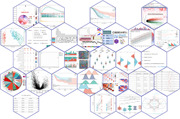- Record: found
- Abstract: found
- Article: found
Sangerbox: A comprehensive, interaction‐friendly clinical bioinformatics analysis platform

Read this article at
Abstract
In recent decades, with the continuous development of high‐throughput sequencing technology, data volume in medical research has increased, at the same time, almost all clinical researchers have their own independent omics data, which provided a better condition for data mining and a deeper understanding of gene functions. However, for these large amounts of data, many common and cutting‐edge effective bioinformatics research methods still cannot be widely used. This has encouraged the establishment of many analytical platforms, a portion of databases or platforms were designed to solve the special analysis needs of users, for instance, MG RAST, IMG/M, Qiita, BIGSdb, and TRAPR were developed for specific omics research, and some databases or servers provide solutions for special problems solutions. Metascape was designed to only provide functional annotations of genes as well as function enrichment analysis; BioNumerics and RidomSeqSphere+ perform multilocus sequence typing; CARD provides only antimicrobial resistance annotations. Additionally, some web services are outdated, and inefficient interaction often fails to meet the needs of researchers, such as our previous versions of the platform. Therefore, the demand to complete massive data processing tasks urgently requires a comprehensive bioinformatics analysis platform. Hence, we have developed a website platform, Sangerbox 3.0 ( http://vip.sangerbox.com/), a web‐based tool platform. On a user‐friendly interface that also supports differential analysis, the platform provides interactive customizable analysis tools, including various kinds of correlation analyses, pathway enrichment analysis, weighted correlation network analysis, and other common tools and functions, users only need to upload their own corresponding data into Sangerbox 3.0, select required parameters, submit, and wait for the results after the task has been completed. We have also established a new interactive plotting system that allows users to adjust the parameters in the image; moreover, optimized plotting performance enables users to adjust large‐capacity vector maps on the web site. At the same time, we have integrated GEO, TCGA, ICGC, and other databases and processed data in batches, greatly reducing the difficulty to obtain data and improving the efficiency of bioimformatics study for users. Finally, we also provide users with rich sources of bioinformatics analysis courses, offering a platform for researchers to share and exchange knowledge.
Abstract
Sangerbox with a user‐friendly interface supports differential analysis, correlation analyses, pathway enrichment analysis, weighted correlation network analysis, and so on. A new interactive plotting system that allows users to adjust the parameters in the image. It has organized GEO, TCGA, ICGC, and other databases; a rapid batch processing reduces the difficulty in data acquirement, greatly improving the efficiency.
Related collections
Most cited references24
- Record: found
- Abstract: found
- Article: not found
Gene set enrichment analysis: A knowledge-based approach for interpreting genome-wide expression profiles

- Record: found
- Abstract: found
- Article: found
limma powers differential expression analyses for RNA-sequencing and microarray studies

- Record: found
- Abstract: found
- Article: found
